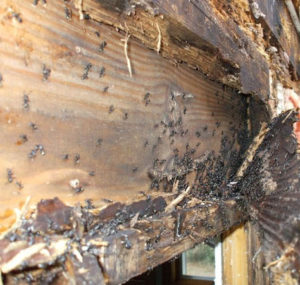Our relationship with water and moisture is a contradictory one one. Water is necessary for all life, but moisture problems are the most damaging concern in many buildings. A moderate amount of indoor moisture is desirable. Indoor relative humidity up to about 55% is acceptable. However excess airborne moisture endangers the health of occupants, shortens the life of buildings, and causes high energy costs.

Bio-Contaminants
Excess moisture encourages the growth of mold, mildew, fungus, bacteria, and other biological contaminants. These bio-contaminants thrive in warm, dark, moist environments such as building cavities and air-conditioning coils.
Occupants may not notice biological pests while they damage framing, sheathing, insulation, and interior finish. Mold and fungus in air conditioning systems can distribute toxic spores throughout a building.
Bio-contaminants contribute to health problems such as allergies and asthma. Poorly ventilated homes are a prime suspect in the increasing incidence of allergies and asthma.
Energy Impacts of Moisture Problems
Moisture-laden insulation loses much of its resistance to heat flow. A wet house rarely provides good comfort and it consumes more energy to heat and cool than a dry one.
High relative humidity forces and air conditioner to use excessive electricity to remove water vapor from the indoor air. During the summer, moisture sources such as damp basements and unvented space heaters lead to excessive energy.

Building Durability
Water vapor condensation and water leakage are the two most serious problems for the durability of buildings worldwide. Pests like mold, rot, termites, and carpenter ants can’t get a foothold in a building without a source of water. Water also causes problems like paint peeling, frost heaving, and efflorescence. Frost heaving can move building foundations and damage building components. Efflorescence is the process of water absorbing components of masonry materials such as lime and depositing the lime at the surface of the masonry. Efflorescence eventually damages and weakens the masonry wall.
Ventilation and Moisture Problems
As with most pollutants, controlling moisture at its source is the best solution. Ventilation employs dry outdoor air to reduce indoor relative humidity. Moisture control is one of the main tasks that ventilation achieves, especially in airtight buildings. However, ventilation can’t overcome high relative humidity caused by large and persistent moisture sources. Wet crawl spaces, humidifiers, or misaligned sprinklers create too much moisture for ventilation to control.
Further Reading
